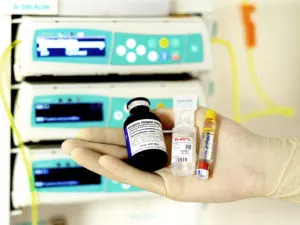Sono Photodynamic Therapy (SPDT) is a new, non-invasive treatment, designed to target and destroy cancer cells with minimal effects on healthy tissue.
SPDT combines light (photodynamic) and sound (sonodynamic) therapies to treat cancer. The combination of these methods helps make cancer treatment more effective, and with fewer side effects than conventional treatments.
SPDT has the potential to treat solid tumors, leukemia, and even atherosclerosis. The treatment essentially uses energy to destroy tumors, instead of substances such as chemotherapy.
PDT on its own is used for more superficial cancer types such as prostate, breast, and skin cancer, but when combined with SDT, it has been shown to be efficient for deep-seated tumors such as bowel and ovarian cancer, as well as metastatic cancer, in particular when the cancer has spread to bone, lung, and liver tissues.
How Sono Photodynamic Therapy Works
SPDT works by applying light and sound along with a sensitizing agent, sometimes called a sonosensitizer.
The sensitizing agent is absorbed by the tumor and responds to the specific frequencies of the applied light and sound. This response generates a reactive oxygen molecule, which essentially “explodes” the cancer cell, destroying it and leaving healthy tissue unharmed.
SPDT also modulates the immune system and disrupts the growth of tumor blood vessels that feed cancer cells. It does this without harming the normal blood vessels which are vital for healthy tissue.
Sono-photo dynamic therapy is a non-invasive, repeatable form of cancer therapy. It can be used several times to effectively treat cancer with minimal side effects.
Sono Photodynamic Therapy Effect on Other Therapies
SPDT Works Best in Combination With Other Therapies and may enhance the effect of other therapies.
Sono-photodynamic therapy can work with:
- Hyperthermia
- Intravenous botanicals, such as vitamin C
- Chemotherapy, especially in breast cancer patients
- Detoxification treatments, which help remove the buildup of toxins in the body during cancer treatment (especially from the breakdown of cancer cells)
- Nutritional interventions
- Oxygenation
The goal is to truly integrate cancer treatment and remove burdens on the immune system.
Benefits of Sono Photo Dynamic for Cancer
Unlike many conventional therapies for cancer, SPDT reduces harm to other body areas while targeting cancer cells.
SPDT also doesn’t suppress immune function. In fact, it can trigger the immune system to deal with the affected site, regulating abnormal cell and blood vessel growth to modulate tumors.
This therapy helps patients avoid invasive treatments such as surgery or radiation that can have dramatic, negative effects, some of them, for the long-term.
How Is Sono Photodynamic Administered?
These are the main steps:
- The sensitizing agent is put in the bloodstream via an IV. Some sensitizing agents can also be taken orally. Others can be injected directly into the tumor. They may also be applied topically in cases such as skin cancer.
- Cancer cells absorb the sensitizer while healthy cells reject it. This could take a few hours or a few days, depending on the mode of administration and the sensitizer dose.
- Light and sound are applied, which causes the cancer cells to react and form an oxygen molecule that kills the cells. SPDT also destroys the blood vessels that feed cancer cells.
- Patients are generally are not “cured” with one treatment. Depending on your type and stage of cancer, you may need repeated treatments. In some cases, the therapy can be done at home over a period of time.
There are a few methods and devices used that can administer SPDT depending on your cancer. These could include:
- Light beds (for whole-body treatment)
- IV fiberoptic laser
- Intratumoral laser
- Endoscopic laser
- Ultrasound guidance colonoscope
- Topical light devices, such as for skin cancer
- Cranial LED device, such as for brain cancer
These modes of administration can even include wearable devices that patients can take home to use, such as wrist-wearable intranasal (in-nose) and intraaural (in-ear) devices.
Should You Use Sono Photodynamic Therapy?
Conventional therapy often looks at SPDT as a last resort. But it can be an effective, minimally invasive option for patients with cancer long before that.
Surgery for certain types of cancer can take months, if not years, to recover from, and that’s if the cancer doesn’t come back. Recovering from SPDT can take as little as a day to a few weeks, depending on the cancer location and the intensity of the treatment.
What Does the Research Say?
In 2016, a comprehensive review of sonodynamic therapy in cancer treatment found a significant body of data that demonstrated therapeutic effectiveness particularly when combined with other therapies.
In 2020, a new study looked at new technologies meant to combat some of the limitations of SPDT, namely the treatment’s ability to specifically target tumors, reach deep inside of them, and cope with worsening conditions as the tumor progresses. The research yielded very strong results, making SPDT an even more promising option as an alternative treatment.








